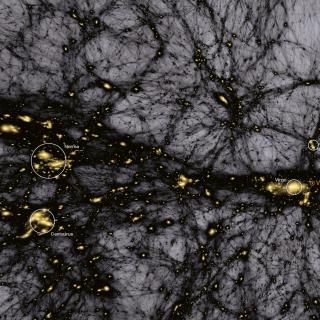Bibcode
Forero Sánchez, D.; Kitaura, F. -S.; Sinigaglia, F.; Coloma-Nadal, J. M.; Kneib, J. -P.
Bibliographical reference
Journal of Cosmology and Astroparticle Physics
Advertised on:
7
2024
Citations
1
Refereed citations
1
Description
Modern galaxy surveys demand extensive survey volumes and resolutions surpassing current dark matter-only simulations' capabilities. To address this, many methods employ effective bias models on the dark matter field to approximate object counts on a grid. However, realistic catalogs necessitate specific coordinates and velocities for a comprehensive understanding of the Universe. In this research, we explore sub-grid modeling to create accurate catalogs, beginning with coarse grid number counts at resolutions of approximately 5.5 h -1 Mpc per side. These resolutions strike a balance between modeling nonlinear damping of baryon acoustic oscillations and facilitating large-volume simulations. Augmented Lagrangian Perturbation Theory (ALPT) is utilized to model the dark matter field and motions, replicating the clustering of a halo catalog derived from a massive simulation at z = 1.1. Our approach involves four key stages: Tracer Assignment: Allocating dark matter particles to tracers based on grid cell counts, generating additional particles to address discrepancies. Attractor Identification: Defining attractors based on particle cosmic web environments, acting as gravitational focal points. Tracer Collapse: Guiding tracers towards attractors, simulating structure collapse. Redshift Space Distortions: Introducing redshift space distortions to simulated catalogs using ALPT and a random dispersion term. Results demonstrate accurate reproduction of monopoles and quadrupoles up to wave numbers of approximately k = 0.6 h Mpc-1. This method holds significant promise for galaxy surveys like DESI, EUCLID, and LSST, enhancing our understanding of the cosmos across scales.
Related projects

Cosmology with Large Scale Structure Probes
The Cosmic Microwave Background (CMB) contains the statistical information about the early seeds of the structure formation in our Universe. Its natural counterpart in the local universe is the distribution of galaxies that arises as a result of gravitational growth of those primordial and small density fluctuations. The characterization of the
FRANCISCO SHU
KITAURA JOYANES